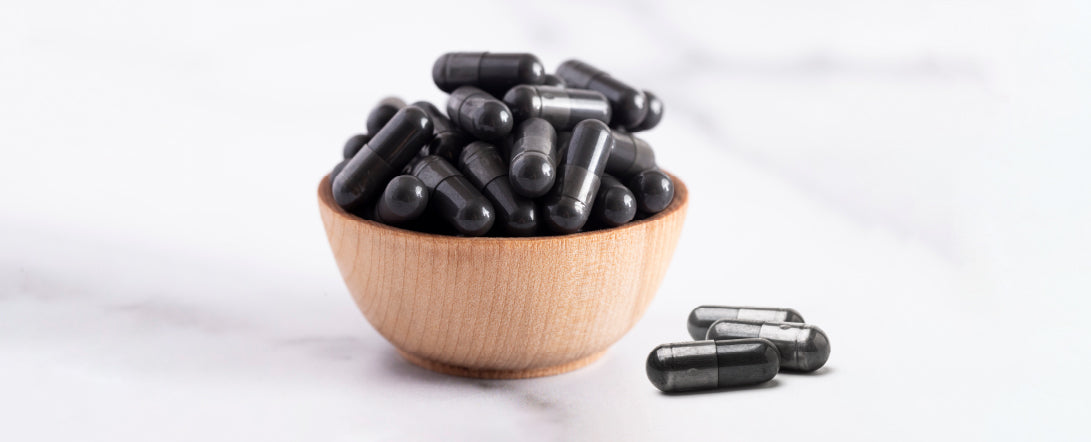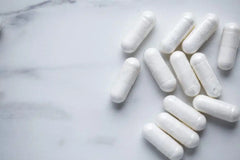WHAT ARE TOXIN BINDERS?


Binders are natural compounds that have an affinity for specific toxins and may adhere or ‘bind’ to them in the GI tract for effective removal from the body.
You are probably familiar with activated charcoal. Activated charcoal is a byproduct of burning a carbon-containing substance, such as bamboo or coconut shells. This binder contains millions of tiny pores and has been shown to adhere to toxins produced by harmful gut bacteria, pesticides, and mold toxins, which are known as “mycotoxins.” It is also effective at binding gas in the intestine, which is why it can be helpful for bloating. (Source, Source, Source, Source)
Activated charcoal is one type of natural binder, but there are many others that support the removal of a variety of toxicants. Because different binders have affinities for different toxins, it can be beneficial to take a few types of binding agents when detoxing. For example, bentonite clay, a creamy gray volcanic ash, has been shown to attach to harmful heavy metals like cadmium and lead. Zeolite, a natural compound also derived from volcanic ash, is a star heavy metal binder; it has been found to help reduce lead absorption in the gut by up to 70 percent! Modified citrus pectin, a dietary fiber derived from the white fleshy inner portion of citrus peels, helps bind lead, arsenic, and cadmium. To ensure you are getting the most out of your binder and supporting the removal of a wide spectrum of toxins, it is best to consume an array of different binders rather than a single binder. (Source, Source, Source)
It is important to note that binders may also bind to pharmaceutical drugs, reducing their absorption and efficacy. For instance, activated charcoal is administered in medical settings to counteract poisoning in cases of pharmaceutical drug overdoses. This is why it is important to take binders well in advance or well after taking medications. If taking medications, talk with your doctor to determine the best time to take your binder. (Source)
The Many Benefits of Binders
Binders Support Phase III Detoxification and the Removal of Toxins
When your body processes toxins, the toxins must proceed through three stages of metabolism, denoted as Phase I, Phase II, and Phase III of detoxification. Phase I uses cytochrome P450 enzymes to initiate several biochemical processes, including oxidation and conjugation, to prepare toxins for eventual elimination. In some cases, Phase I can create free radical byproducts, molecules with an unpaired electron (think back to your chemistry classes!) that desperately want to “steal” electrons from other molecules. As these greedy free radicals steal electrons, they can damage your DNA and parts of your cells in the process. In other words, we want to usher toxins through Phase I to Phase II promptly! (Source)
In Phase II, your body attaches various compounds, including glutathione, to toxins to further prepare them for elimination. Once a toxin has gone through Phase II, it moves along to Phase III.
Phase III of detoxification is the final step in toxin processing, involving the movement of toxins out of cells in your liver, kidneys, and gut and into blood circulation, where the toxins can be prepared for elimination through your stool and urine. Unfortunately, many detox products and “cleanses” on the market fail to support Phase III of detoxification. This means toxins are left to recirculate between your gut, bloodstream, and liver. This is NOT something you want to happen. This is where binders come in to play!
Binders are supplements that uniquely support phase III detoxification by “mopping up” toxins in your gut so they can be removed when you have a bowel movement instead of recirculating through your body. Examples of binders include activated charcoal, bentonite clay, and zeolite.
Binders Help Occasional GI Upset
One of the amazing effects of natural binders is that they can help with occasional GI upset. GI upset can be caused by several factors, including gut bugs, eating out, or indulging too heavily in sweet, starchy, or fatty foods that trigger intestinal gas and discomfort. Binders may help by attaching to harmful gut bugs and reducing intestinal gas so these substances can be eliminated in your stool. (Source, Source, Source).
Traveling internationally anytime soon? Binders can come in handy while trying new foods, especially when sourcing, quality of preparation, and use of clean water is unknown.
Binders May Help You Recover from a Fun Night Out
Planning to enjoy some cocktails this weekend? Consider taking binders afterward; binders may help mop up and detoxify alcohol metabolites, so you feel more clear-headed and bright the following morning! Binder can also support the occasional stomach upset that may come with too many drinks. As always, we recommend a full spectrum binders for optimal effects.
The Bottom Line on Binders
Binders are truly versatile supplements, helping your body remove toxins, bounce back from occasional GI upset, and potentially feel better after an evening of drinks! If you want to be proactive about reducing your toxin burden, you’ll want to keep binders on hand. Look for a product that contains an array of binders, not just activated charcoal, for the most comprehensive coverage.


